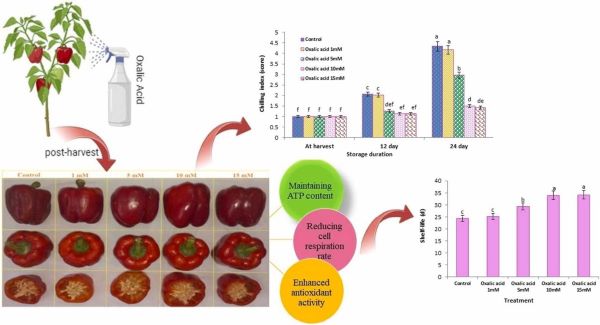Actualidad
Oxalic Acid Alleviates Chilling Injury in Postharvest Sweet Bell Pepper
Oxalic acid alleviates damage during the cold storage of sweet bell pepper by positively influencing the accumulation of glycine betaine (osmoprotectants) and controlling the respiration rate of cells as well as the activity of the NADPH oxidase enzyme
Sweet bell pepper (Capsicum annuum L., family Solanaceae) originates from South and Central America and has significant nutraceutical value.
The bell pepper (also called "bell pepper") not only contains essential vitamins such as A, thiamine (B2), riboflavin (B6), and niacin (B1), but also boasts an impressive array of minerals, including sodium, iron, phosphorus, calcium, and particularly potassium. Additionally, it is noted for its anti-carcinogenic substances.
Peppers are harvested at the mature green stage (or other colors) and stored at a temperature of 7.5 °C or slightly higher to protect them from risks including fungal contamination, fruit softening, and rapid desiccation due to reduced turgor, starch structure collapse, and chemical changes in the cell wall, which lead to quality reduction and significantly shorten shelf life.
Storage at temperatures below 7 °C can change the fruit color and decrease its firmness and qualitative parameters.
Cold storage is one of the most common techniques to extend the shelf life of crops. It reduces the metabolic rate of plant cells, delays senescence, and maintains quality, but in some fruits and vegetables, low temperatures cause significant damage that can negatively affect their quality and decrease the efficiency of this technique.
Oxalic Acid, an Organic Acid
Natural organic acids are safe and effective. Oxalic acid* is one of the most efficient organic acids for alleviating the adverse effects of abiotic stress in horticultural crops.
It was first introduced in 1957 and used as an antiseptic for swimming pools, drainage systems, irrigation systems, and kitchen and dining utensils and equipment.
In recent studies, exogenous application of oxalic acid was found to delay the senescence process of crops, improve disease resistance, reduce cold damage, and browning during postharvest.
This compound has no negative effects on human health and the environment, thus having no application restrictions, and the World Environmental Protection Organization has classified it as one of the compounds with no adverse effects.
Moreover, oxalic acid is known as an anti-stress agent and has anti-aging effects in agricultural crops; it has antioxidant properties and plays an important role in regulating ethylene signaling and generally reducing its biosynthesis rate.
Additionally, oxalic acid increases the systemic resistance of plants by enhancing the activity of antioxidant enzymes and stabilizing the cell membrane.
Improvement of Preservation
Over the past decade, various positive roles of oxalic acid in improving the preservation of horticultural crops stored under cold conditions have been reported in different studies. For example, postharvest treatment of green bell pepper with oxalic acid led to an increase in proline accumulation by enhancing the activity of ∆1-pyrroline-5-carboxylate synthetase and ornithine δ-aminotransferase, and a decrease in the activity of proline dehydrogenase.
In another study, pre-storage treatment of mango fruits with oxalic acid extended the shelf life of the fruits mainly by improving the antioxidant activity of the cells. The activity of the enzymes superoxide dismutase, catalase, ascorbate peroxidase, and glutathione reductase in treated fruits was notably higher than in untreated fruits.
Also, the respiration rate of peach fruits treated with 1 mM oxalic acid was significantly lower than that of control fruits.
A recent study verified that treatment with 10 mM oxalic acid significantly reduces the negative effects of storage treatment at less than 4 ºC. The ATP (energy) content of the fruits is maintained, and after 24 days of storage, the enzyme NADPH oxidase activity rate in treated fruits was lower, and extending the storage duration did not cause an increase in the cell respiration rate.
Potential for Use
Oxalic acid, as a low-risk and environmentally friendly compound, can be an appropriate option for preharvest application to extend the shelf life of bell pepper fruits.
The most important effects of oxalic acid application are the improvement of enzymatic and non-enzymatic antioxidant activities, the increase in osmoprotectant accumulation rate, and the regulation of cellular energy metabolism.
Preharvest treatment of bell pepper with oxalic acid can be introduced as an effective technique to overcome the adverse effects of cold stress during storage.

Graphical Summary According to Alaboudi, N.A.H. et al., 2024
Oxalic acid is found in plants of the genus Oxalis, and also in spinach, tomatoes, yams, and other vegetables.
Sources
Alaboudi, N. A. H.; Hatamnia, A. A.; Mohammadi, M.; Ranjbar, M. E. (2024). Oxalic acid alleviates chilling injury and positively influences post-harvest parameters of sweet bell pepper by affecting glycine betaine accumulation, cells respiration rate and NADPH oxidase enzyme activity during cold storage. Postharvest Biology and Technology, 212: 112905.
Images
https://conservaslareceta.com/en/product/pimientos-dulces-fritos-en-aove-250-gramos/ Accessed on 06/06/2024.
https://pt.wikipedia.org/wiki/%C3%81cido_ox%C3%A1lico#:~:text=O%20%C3%A1cido%20ox%C3%A1lico%20ou%20%C3%A1cido,forte%20que%20o%20%C3%A1cido%20ac%C3%A9tico. Accessed on 06/06/2024.













